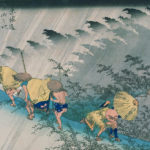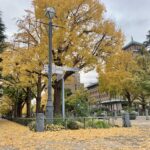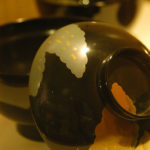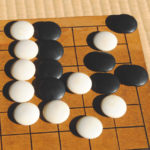
A stone lantern exerts its dignified presence beside Myojin pond in Hagi, Yamaguchi Prefecture.
DAVID CAPEL
To think of crafted items in Japan is rarely to think in terms of stone. The country that is home to the world’s oldest and largest wooden buildings has displayed such genius in working with the organic material that the efforts in stone tend to get overlooked. Yet with many of the country’s castles where the once elegant multistoried wooden donjon became lost through conflagration or other incursion, the remaining rock-solid base of often gigantic, but perfectly interlocking, stones shows that the Japanese are no slouches when it comes to creations with the more durable material. Despite the grandeur, though, of such monumental constructs, the most emblematic of Japan’s efforts in stone are almost certainly its lanterns.
As with a good many traditional cultural phenomena in Japan, stone lanterns originated in China. But also as with a good number of Chinese cultural imports, the subsequent development in Japan exceeded that in the native country. Stone lanterns tend to be something of a rarity these days in China, but, with small exaggeration, they are absolutely everywhere in Japan.
The story has it that the first stone lantern in Japan was erected in 594 at a Buddhist temple built for Prince Shotoku, prince regent and a figure of enormous esteem. Not only did the prince become dear to Japanese hearts, he also grew very dear to their wallets: before being supplanted in 1984, his was the face that graced 5,000- and 10,000-yen notes. The prince was tireless in his efforts to promote the incipient faith of Buddhism, which had been introduced less than half a century earlier from Korea. As Buddhist temples began to spread around the country, so did stone lanterns, which were set up in front of the main buildings of worship or elsewhere in the temple precincts, such as along paths by way of illumination. By the Heian period (794–1185), Shinto priests had decided that stone lanterns were simply too good an idea to be monopolized by Buddhism, and so they also began to appear in the grounds of Shinto shrines.
Stone lanterns made a further departure from their temple origins in the Azuchi-Momoyama period (1568–1603), when masters of the tea ceremony recognized the lanterns’ dignified aesthetic appeal and thought they would make an excellent feature in the tea garden (the area around the tea house in which the tea ceremony takes place). Tea gardens had a tremendous influence on the overall development of Japanese gardens, and so such elements as stone lanterns and stepping stones became standard features of the country’s gardens.
As might be supposed, this popular feature of temples and gardens underwent considerable development over the centuries, and a variety of forms came into being. The most frequently encountered types are known as tachidoro, whereby the lantern stands upon a stone post, which in turn rests upon a pedestal. With another type, known as yukimidoro, the lantern sits upon legs. Undoubtedly the best-known lantern of this type is the one called Kotoji in the garden of Kenrokuen, which has long been classed as one of Japan’s Three Finest Gardens, in Kanazawa, Ishikawa Prefecture. This bipedal lantern, with one of its legs standing in a pond and the other on land, is so famous that it practically serves as a symbol of the entire city.
Originally, the lighting of the lantern fulfilled an offertory function to Buddha and other deities. Nowadays, stone lanterns find a place in gardens simply because people like the shape of the things, and even though the lanterns have a hollowed-out section to contain a candle or lamp, they tend not to be lit. In some places, where practicality wins out over adherence to traditional aesthetics, the lanterns are lit by light bulbs. One place, though, that quite definitely eschews such innovative moves is Kasuga-jinja shrine in the former capital of Nara, near Kyoto, when twice a year the thousands of stone lanterns that line the approach to the shrine are lit. The lantern light is entirely supplied by candles, and there is probably no greater visual testament to the statuesque power of such structures in stone than in these thoroughly delightful midwinter and midsummer displays.
David Capel is a journalist living in Tokyo.








